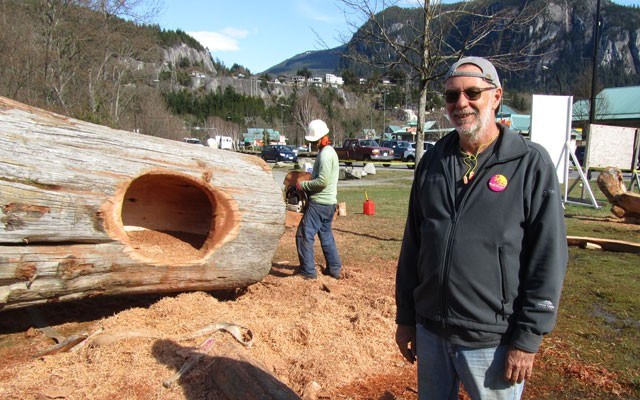Brazilian artist Hugo Franca, who works with discarded wood to carve monumental public sculptures, was in Squamish until April 2 as part of the Vancouver Biennale.
Speaking to Pique through his interpreter, Tais Ribeiro, Franca talked about how happy he and his team were to learn more about the connection between the people living in the Sea to Sky region with the expansive forests that cover it.
He spent two weeks selecting massive red cedar and pine trunks from around the region, moving them to the site and working on them in situ.
Franca's sculpture, currently unnamed, is located on Cleveland Avenue just off the Sea to Sky Highway, next to Squamish Elementary School. The sculptor broke off periodically during the interview to give instructions to his two assistants, who were cutting into the trunks with chainsaws, shaping them.
He is the first of three major artists due to come to Squamish as part of the biennale over the next two years.
Pique: You had a lot of rain to work in. You got the real Squamish welcome.
Hugo Franca: (Laughs) The rain was a real challenge. We can deal with the cold weather; it's great, because we get really hot while working. But now it's dry and it's perfect.
We can see that the people here are so used to the rain all the time. You don't stop your lives. We had a lot of people watching with kids and dogs on the weekend. With this rain in Brazil, everyone would stay home and never leave.
Pique: Tell me about the artwork. It's taking shape as a large circle of different huge pieces in pine and red cedar.
H.F.: Two things. We usually use a curvy cut to better fit with organic forms, the natural shape of the trees. A straight cut is a little too invasive in my conception; you have to go with the wood.
The idea here is that we have a lot of (tree trunks) that are similar. The idea is to create differences in the similarity. I started with similar logs but we are making pieces that are different, harmonious but unique. There is that bench that has a hole, here we have something that is more of a cocoon that you can go inside. And over there will be a more playful piece with a hole and you can go inside and out the other side, like a playground.
It was interesting, we found some rotten parts and after the first cuts we found out about it. That guides the work. My main inspiration is always the tree and the story of each tree... If we have to take a little out because it is rotten then there will be a hole in that place. It's the history of each piece of wood.
Even straight cuts emphasize the natural forms.
Pique: You are used to working with hardwoods and this is softwood. What did you think of working with it?
H.F.: It is easier to carve because it is so soft, but I had concerns about the resistance. Cedar is very resistant. We also had some trouble with the fir. One piece, over there, broke in two because there was a huge rotten part we couldn't see from outside. But we made two pieces instead of one!
We are trying to figure out how these pieces will last, trying to check out the signs of the wood. Where it is more — or less — resistant.
Nature always gives us surprises. The work is very organic in this way.
Pique: Have you become familiar with the way First Nations have used the wood? There are a lot of talented carvers here.
H.F.: Not yet. Not yet. We had a small opportunity by visiting (the Squamish Lil'wat Cultural Centre in) Whistler. We did some research, and I want to research more. In this season, where we are working so much, maybe we will not be able to do all the research. But this means we have to come back to be more involved with the traditions here.
We are also very curious about the (Squamish Days) logger sports competition (which takes place each August). We have to check it out!
For more information visit: www.vancouverbiennale.com.




